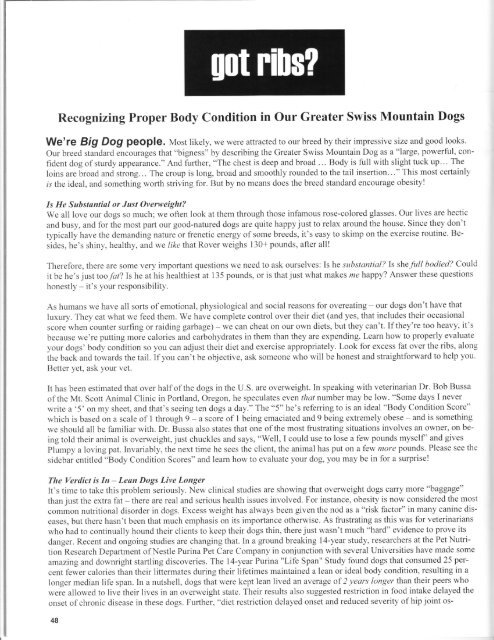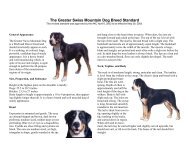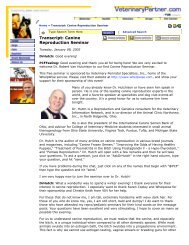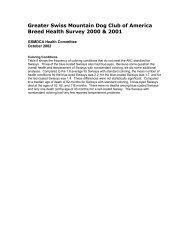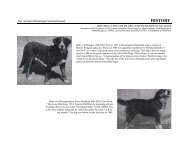Got Ribs? - Greater Swiss Mountain Dog Club of America
Got Ribs? - Greater Swiss Mountain Dog Club of America
Got Ribs? - Greater Swiss Mountain Dog Club of America
Create successful ePaper yourself
Turn your PDF publications into a flip-book with our unique Google optimized e-Paper software.
o<br />
Recognizing Proper Body Condition ln<br />
Our <strong>Greater</strong> <strong>Swiss</strong> <strong>Mountain</strong> <strong>Dog</strong>s<br />
We'fe Big DOg peOple. Most likely, we were attracted to our breed by their impressive size and good looks.<br />
Our breed standard encourages that "bigness" by describing the <strong>Greater</strong> <strong>Swiss</strong> <strong>Mountain</strong> <strong>Dog</strong> as a "large, powerful, confident<br />
dog <strong>of</strong> sturdy appearance." And further, "The chest is deep and broad ... Body is full with slight tuck up... The<br />
ioins are broad and strong... The croup is long, broad and smoothly rounded to the tail insertion..." This most cedainly<br />
rs the ideal, and something worth striving for. But by no means does the breed standard encourage obesity!<br />
Is He Substantial or Just Overweight?<br />
We all love our dogs so much; we <strong>of</strong>ten look at them through those infamous rose-colored glasses. Our lives are hectic<br />
and busy, and for the most part our good-natured dogs are quite happyjust to relax around the house. Since they don't<br />
tlpically have the demanding nature or frenetic energy <strong>of</strong> some breeds, it's easy to skimp on the exercise routine. Besides,<br />
he's shiny, healthy, and we ft*e that Rover weighs 130+ pounds, after all!<br />
Therefore, there are some very important questions we need to ask ourselves: Is he szbslan tial? ls she full bodied? Cortld<br />
it be he's just too/at? Is he at his healthiest at 135 pounds, or is that just what makes ze happy? Answer these questions<br />
honestly - it's your responsibility.<br />
As humans we have a1l sorts <strong>of</strong> emotional, physiological and social reasons for overeating - our dogs don't have that<br />
luxury. They eat what we feed them. We have complete control over their diet (and yes, that includes their occasional<br />
score when counter surfing or raiding garbage) we can cheat on our own diets, but they can't. Ifthey're too heavy, it's<br />
because we're putting more calories and carbohydrates in them than they are expending. Leam how to properly evaluate<br />
your dogs' body condition so you can adjust their diet and exercise appopriately. Look for excess fat over the ribs, along<br />
the back and towards the tail. Ifyou can't be objective, ask someone who will be honest and straightforward to help you.<br />
Better yet, ask your vet.<br />
It has been estimated that over half<strong>of</strong>the dogs in the U.S. are overweight. In speaking with veterinarian Dr. Bob Bussa<br />
<strong>of</strong> the Mt. Scott Animal Clinic in Portland, Oregon, he speculates even that rlirlber may be low. "Some days I never<br />
write a '5' on my sheet, and that's seeing ten dogs a day." The "5" he's referring to is an ideal "Body Condition Score"<br />
which is based on a scale <strong>of</strong> l throughg-ascore<strong>of</strong> l being emaciated and 9 being extremely obese - and is something<br />
we should all be familiar with. Dr. Bussa aiso states that one <strong>of</strong> the most frustrating situations involves an owner, on being<br />
told their animal is overweight, just chuckles and says, "Well, I could use to lose a few pounds myself' and gives<br />
Plumpy a loving pat. Invariably, the next time he sees the client, the animal has put on a few more pottnds. Please see the<br />
sidebar entitled "Body Condition Scores" and leam how to evaluate your dog, you may be in for a surprise!<br />
The Yerdict is In - Lean <strong>Dog</strong>s Live Longer<br />
It's time to take this problem seriously. New clinical studies are showing that overweight dogs carry more "baggage"<br />
than just the extra fat - there are real and serious health issues involved. For instance, obesity is now considered the most<br />
common nutritional disorder in dogs. Excess weight has always been given the nod as a "risk fact<strong>of</strong>' in many canine diseases,<br />
but there hasn't been that much emphasis on its importance otherwise. As frustrating as this was for veterinarians<br />
who had to continually hound their clients to keep their dogs thin, there just wasn't much "hard" evidence to prove its<br />
danger. Recent and ongoing studies are changing that. In a ground breaking 14-year study, researchers at the Pet Nutrition<br />
Research Department <strong>of</strong> Nestle Purina Pet Care Company in conjunction with several Universities have made some<br />
amazing and downright startling discoveries. The l4-year Purina "Life Span" Study found dogs that consumed 25 percent<br />
fewer calories than their littermates during their lifetimes maintained a lean or ideal body condition, resulting in a<br />
longer median life span. In a nutshell, dogs that were kept lean lived an av erage <strong>of</strong> 2 years longer than Iheir. peers who<br />
weri allowed to live their lives in an overweight state. Their lesults also suggested restriction in food intake delayed the<br />
onset <strong>of</strong> chronic disease in these dogs. Further, "diet restriction delayed onset and reduced severity <strong>of</strong> hip joint os-<br />
48
:eoarthritis, thus favorably affecting both duration and quality <strong>of</strong> life."<br />
i,\-e've all been told that we should keep our puppies lean and trim to<br />
:rinimize stress on their fast-growing joints, and now there's evidence<br />
:hat says we should continue this practice throughout their lifetime. A<br />
:"eoccurring point or statistic in many <strong>of</strong> the speakers' discussions at<br />
.ne 2001 AKC/CHF NPCCH Conference - whether their area <strong>of</strong> ex-<br />
:eftise was cancer, orthopedics, genomics, or reproductive health -<br />
,i as the importance and the direct corelation between keeping animals<br />
"iirn and longevity. One speaker put it pretty succinctly when she said,<br />
' One <strong>of</strong> the most important things we can do for our dogs to reduce<br />
:le risk <strong>of</strong> disease is to keep them THIN!"<br />
Fatter is Prettier!?<br />
\-ou might be saying to yourself "this doesn't apply to my <strong>Swiss</strong>y, he<br />
:eally isn't obese, and he's just carrying some extra weight." That may<br />
:e true, but it's a slippery slope. I've heard people say they feel they<br />
should keep their dogs on the heavy side in order to have a "reserve"<br />
.n case he does contract some debilitating disease. One <strong>of</strong> the scariest<br />
"excuses" I've heard was an owner who actually told me he kept his<br />
Jog fat - because that way she was less active, and less likely to get<br />
lurt! Some people even just feel a heavy dog "looks better." But in<br />
:rost cases, the sad reality is they don't even reahze their pet is over-<br />
,,r eight. Our dogs, being big, tend to be able to carry quite a bit <strong>of</strong> extra<br />
,,r eight before it really stands out. And then there's that mindset that<br />
rhese dogs are supposed to be big. Also, as puppies they grow so fast,<br />
and their caloric needs during that growth phase are so high, we <strong>of</strong>ten<br />
tail to reduce their intake appropriately as they reach maturity. The<br />
rrrale that needed 6 cups a day when he was eleven months may only<br />
need 3 cups a day at three years.<br />
-\nd it's not just our beloved family pets that are guilty <strong>of</strong> indiscernible<br />
n aists and rolling backs. Sadly, it seems there's a general belief that<br />
show dogs need to carry extra pounds in order to win (sort <strong>of</strong> like the<br />
prize-winning steer at the County Fair). If this is true, and judges are<br />
arvarding overweight dogs over fit ones - mistaking that extra weight<br />
tor the desired "substance" in our breed - then our Judges' Education<br />
Committee has their work cut out for them - as this is a dangerous<br />
trend and an unhealthy presumption. And we're not alone - it's not<br />
iust occurring in our breed! During a question and answer period at the<br />
recent AKC/CHF NPCCH Conference, an attendee talked about her<br />
tu,o "Top 5" Irish Wolfhounds (who obviously do their share <strong>of</strong> winning)<br />
and said she is constantly told, even by judges , that they arc too<br />
thin, and they'd do much better if they carried more weight. In reality<br />
her dogs are not too thin; she stated they have a body condition score<br />
<strong>of</strong> 5. Another commented that her Champion Rottweiler was 120 lbs<br />
during his very successful show career, and yet he weighed 100 when<br />
he was competitive in agility. It is undeniable which weight is most<br />
healthy for him.<br />
Medicul Reasons for Weight Gain<br />
There are some medical reasons which contribute to weight gain and<br />
obesity, though rare. Hypothyroidism is the classic disease state that<br />
can lead to obesity in dogs. Others endocrinopathies such as hyperadrenocorticism<br />
(Cushing's disease) have been implicated as underlying<br />
causes in weight gain, as have some neurological anomalies that<br />
Body Condition Scores<br />
Understanding your dog's body condition<br />
Veterinarians use this scoring chart to assess<br />
whether a dog is at his ideal weight -<br />
we shoutd too!<br />
loo lntn<br />
1 <strong>Ribs</strong>, lumbar vertebrae, pelvic bones and<br />
a[[ bony prominences evident from a distance.<br />
No discernible body fat. Obvious loss<br />
<strong>of</strong> muscte mass.<br />
2 <strong>Ribs</strong>, lumbar vertebrae and pelvic bones<br />
easily visibte. No palpable fat. Some evidence<br />
<strong>of</strong> other bony prominence. Minimal<br />
loss <strong>of</strong> muscle mass"<br />
3 <strong>Ribs</strong> easi[y palpated and may be visible<br />
with no palpable fat. Tops <strong>of</strong> lumbar vertebrae<br />
vis'ible. Pelvic bones becoming prominent.<br />
Obvious wist.<br />
ldeal<br />
4 <strong>Ribs</strong> easity patpable, with minimat fat<br />
covering. Waist easity noted, viewed from<br />
above. Abdominal tuck evident.<br />
5 <strong>Ribs</strong> patpabte without excess fat covering"<br />
Waist observed behind ribs when<br />
viewed from above. Abdomen tucked up<br />
when viewed.<br />
Too Heavy<br />
6 <strong>Ribs</strong> patpabte with stight excess fat covering.<br />
Waist is discernible viewed frorn<br />
above but is not orominent. Abdominal<br />
tuck apparent.<br />
7 <strong>Ribs</strong> patpable with difficutty; heavy fat<br />
cover. Noticeabte fat deposits over lumbar<br />
area and base <strong>of</strong> tail. Waist absent or<br />
barety visible. Abdominal tuck may be present.<br />
8 <strong>Ribs</strong> not palpabte under very heavy fat<br />
cover, or patpabte on[y with significant<br />
pressure. Heavy fat deposits over lumbar<br />
area and base <strong>of</strong> tail. Waist absent. No abdominal<br />
tuck. Obvious abdominal distension<br />
may be present.<br />
9 Massive fat deposits over thorax, spine<br />
and base <strong>of</strong> tail. Waist and abdorninal tuck<br />
absent. Fat deposits on neck and limbs.<br />
Obvious abdominal distention.<br />
49
can cause an increase in appetite (polyphagia). Likewise, some dogs that are treated with corticosteroids for other conditions<br />
can also become polyphagic and therefore become obese. With all that said, it should be remembered that once<br />
these diseases are identified and regulated with supplementation, the root <strong>of</strong>the problem is eliminated, and yet many <strong>of</strong><br />
these dogs remain obese - because they continue to be overfed and under exercised.<br />
There has also been a strong correlation cited between spaying and neutering <strong>of</strong> animals and weight gain - not because<br />
<strong>of</strong>any disease state, but because <strong>of</strong>a cause-and-effect relationship, i.e. a decreased metabolic rate associated with the<br />
sterilization and the continuation <strong>of</strong>the same food./exercise schedule as before the procedure. The dog's metabolism t}?ically<br />
slows down when the reproductive organs and associated hormonal changes are removed, and yet diet adjustments<br />
<strong>of</strong>ten are not made.<br />
Much more <strong>of</strong>ten than there being a disease state which leads to obesity, there is obesity which can lead to disease. Excessive<br />
weight has been directly related to:<br />
. lameness and arthritis<br />
. cranial cruciate ruptures (called anterior cruciate ruptures, or ACL in humans)<br />
r diabetes mellitus<br />
I heart disease<br />
l exercise intolerance and overheating<br />
. increased anesthetic and surgical risks<br />
. increased incidence learly onset <strong>of</strong> cancer<br />
o reduced life span<br />
The dog on the right is in exceltent condition with firm muscle<br />
tone. Waist is defined directty behind ribs. <strong>Ribs</strong> were easily<br />
palpabte, yet had sufficient covering. Body cond'ition score 5.<br />
The dog on the teft is too heavy, note the fat deposits around<br />
hips and base <strong>of</strong> tait. Losing definition <strong>of</strong> waistline. Effort<br />
needed to palpate ribs and pelvic structures. Body Condition<br />
score 7<br />
50<br />
Recognizing und obtuining the ldeal Body Condition<br />
And sc I ask, have you "got ribs?" As guardians <strong>of</strong> our<br />
dogs and our breed, we need to educate ourselves on what<br />
proper body condition looks andJbels like. We owe that<br />
much to our dogs. Our breed standard does state, "... the<br />
body is full with slight tuck up." This does not mean that<br />
the abdomen is convex! The body should be full, but it<br />
should be the frame and stmcture that create the size and<br />
depth, not distension and fat build up. Study the Body<br />
Condition Score sidebar,, and compare those ratings, honestly,<br />
to your dog. Can you see a well defined waistline?<br />
Can you rest your hand on his side, and lbel the last two<br />
ribs without effort? Can you locate some pelvic bones<br />
easily? If not, if it takes a spirited rub or a single finger<br />
wiggling around to find a rib, you need to make some<br />
changes.<br />
Assuming your dog is healthy and not suffering from any<br />
<strong>of</strong> the afore mentioned diseases, he does not necessarily<br />
need a change in diet; probably the most effective weight<br />
loss tool is simply increasing exercise. As with any<br />
change, make it gradually - don'f expect your couch potato<br />
to suddenly be up for a five-mile forced march or a<br />
gallop next to the bicycle on the weekends! Make a realistic<br />
plan that you can stick with for the long mn - you'll<br />
both be better <strong>of</strong>f for it. An old saying goes, "If you're<br />
dog's fat, you're not getting enough exercisel" As is the<br />
case with a person who needs or wants to lose weight, the<br />
best way to go about it is gradually. This is best accomplished<br />
through reducing caloric intake and increasing<br />
physical exertion; in the case <strong>of</strong> dogs, a decrease <strong>of</strong> one
:-r two percent <strong>of</strong>their initial weight each week is a safe pace.<br />
3e1ond increasing actMty levels, a decrease in food intake may likely be necessary. When determining how much to<br />
::ed, ifyou're feeding a commercial diet, you should be using manufacturer's feeding recommendations (found on the<br />
: :gs) as an general starting point - not as something set in stone. Tlpically, those recommendations are for much more<br />
::od than the average dog needs. Our <strong>Swiss</strong>ies tend to be "easy keepers" in relation to their size; their calorie requirerents<br />
just don't seem to be as high as you'd think.<br />
: -'metimes a change in food will be the key to inciting weight loss. This is a good subject to talk to your vet and breeder<br />
::out and so I won't go into a lot <strong>of</strong> depth here. They may want you to simply try decreasing the amount <strong>of</strong> your current<br />
: -'od (and increase exercise, <strong>of</strong> course !), other times they will have you try a "prescription" or specific weight loss diet,<br />
:rd many times a low-carbohydrate product is more appropriate. Typically the food change is only necessary in severely<br />
:' erweight cases.<br />
: -' show your <strong>Swiss</strong>y how much you love him by spending some extra time playing, take him for a walk. Don't be<br />
::mpted to give him an extra scoop to show your love. Let the "Great" in <strong>Greater</strong> <strong>Swiss</strong> refer to his stature and character<br />
- not his girth. I recently spoke with a woman who put it pretty well when she said, "if your dog's too fat, there may be<br />
:ore to love, but there will be less time to love him."<br />
Legina Reese<br />
ISMDCA Health Committee<br />
Glossary<br />
-{KC/CIIF NPCCH (National Parent <strong>Club</strong> Canine Health) Conference: A biennial conference co-sponsored by<br />
the <strong>America</strong>n Kennel <strong>Club</strong> Canine Health Foundation and the Nestle Purina Pet Care Company, where representatives<br />
tuom each breed's Parent <strong>Club</strong> are invited to leam about the latest in canine health research and discovery with an emphasis<br />
on genomics and funded programs. Please see additional information in the "Health Committee AKC/CIIF<br />
Conference Report" and the President's message in this issue<br />
Body Condition Scores: ratings to determine a dog's overall body condition. Body Condition Score is the BEST indicator<br />
<strong>of</strong>an individual dog's caloric needs. Please see sidebar for more information<br />
Ideal Body Condition: physical assessment <strong>of</strong>health defined as when you can feel and see the outline <strong>of</strong>a dog's ribs,<br />
there is a waist when viewed from above and the abdomen is tucked up when viewed ftom the side<br />
Endocrinopathies: literally, diseases <strong>of</strong>an endocrine gland. A medical term for a hormone problem<br />
Obesity: obesity in humans is defined as being2jo/o or more over one's ideal weight. In dogs, while there is no set<br />
number, this is a generally accepted figure. More important in identiffing obesity than weight are body condition<br />
scores<br />
Polyphagia: excessive eating/excessive hunger<br />
Risk Facfor: Somethingthat increases one's chances <strong>of</strong> developing a disease<br />
References:<br />
Effects <strong>of</strong> diet restriction on life span and age-related changes in dogs.<br />
Kealy RD, Lawler DF, Ballam JM, Mantz SL, Biery DN, Greeley EH, Lust G, Segre M, Smith GK, Stowe HD. Pet Nurrition<br />
Research Department, Nestle Purina Pet Care Co, St Louis, MO 63164, USA.<br />
Lifelong diet restriction and radiographic evidence <strong>of</strong> osteoarthritis <strong>of</strong> the hip joint in dogs.<br />
Smith GK, Paster ER, Powers MY, Lawler DF, Biery DN, Sh<strong>of</strong>er FS, McKelvie PJ, Kealy RD. Department <strong>of</strong> Clinical<br />
Studies, School <strong>of</strong>Veterinary Medicine, University <strong>of</strong>Pennsylvania, Philadelphia, 19104-6010, USA.<br />
Peggy Root Kustritz, DVM, PhD, DACT, University <strong>of</strong> Minnesota at the AKC CHF National Parent <strong>Club</strong> canine<br />
Health conference, in her presentation "Canine Reproduction"<br />
Robert Bussa, DVM, Mt. Scott Animal Hospital, Portland, OR<br />
The Fat <strong>Dog</strong> Site, http:// www.geocities.com/fatdogsite<br />
Understanding Your <strong>Dog</strong>'s Body Condition, http:// www.purina.com/dogs/health,tsodyCondition.aspx<br />
51


